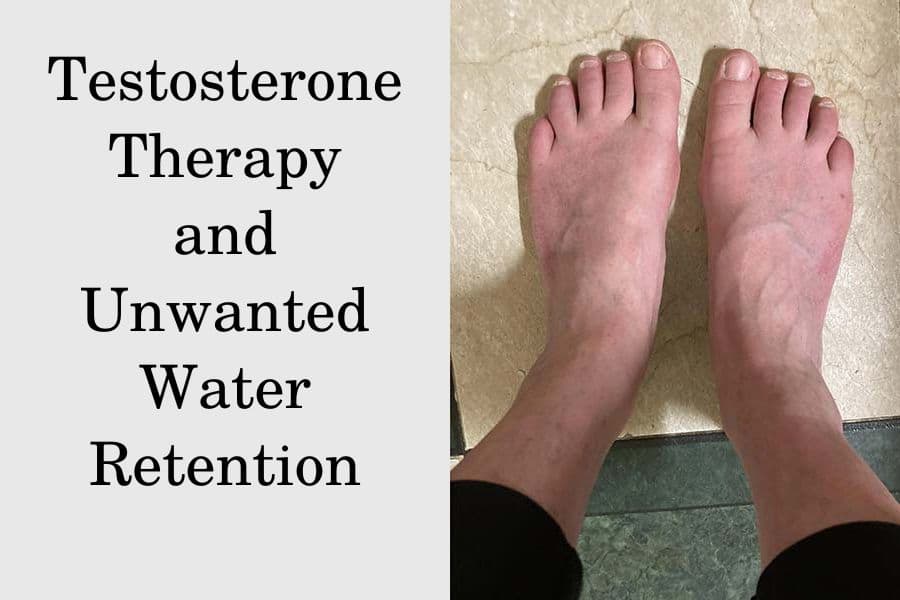In this article
Testosterone replacement therapy (TRT) has become a popular solution for men who suffer from low testosterone (T) levels.
But, many men may not expect to see the scale going up soon after the start of the therapy. That weight gain may occur due to unwanted water retention, which is a well-known side effect of TRT.
This rapid increase in body water can lead to the accumulation of excess fluid in tissues and edema. Men who get affected usually experience only minor water retention, which does not affect their overall health and appearance.
Nevertheless, your doctor will actively monitor your therapy and take measures to prevent the occurrence of edema if you show any signs of water retention.
Does TRT cause water retention?
Testosterone therapy can cause water retention, which usually manifests with a slight increase in body weight. Some patients may also experience transitory reactions such as swollen legs, bloated stomachs, and puffy faces.
The degree of retention caused by TRT is usually mild. Studies show that the increase in total body water related to testosterone use was primarily due to the increased volume of extracellular water. This is the water outside your cells, such as in your blood vessels.
Although fluid retention during TRT is not uncommon, the exact reasons behind this phenomenon are not fully known yet. The retention may be caused indirectly due to the aromatization of the extra testosterone into estrogen.
Testosterone may also have a direct effect on the function of the kidneys because of mild mineralocorticoid effects, similar to hormones such as aldosterone that regulate the balance of water and electrolytes in the human body.
According to the researchers, the extracellular volume and the body weight of the participants on TRT increased by 2 kg on average. Yet, there is no data on how long the water retention may last during TRT.
Likely the elevated extracellular water persists for the whole duration of the TRT. Nevertheless, edemas such as swollen legs or stomachs resolve as the body adapts to the increased levels of body water.
Not everyone on TRT is affected by fluid retention. Individuals with a history of heart, liver, or kidney problems may be at a higher risk of developing edema during TRT.
These conditions are more common among older individuals. Higher doses of testosterone may also increase the risk of edema.
People with chronic kidney or cardiovascular problems may require extra medical attention during TRT, as the excess water retention can increase the strain on these organs and potentially increase the risk of complications.
On the other hand, the increase in water retention during TRT is generally not dangerous for people with low T who are otherwise healthy. Studies do not report an increase in blood pressure or any other health problems related to retention.
Testosterone ester with the least water retention
The severity of water retention may vary between different types of testosterone, depending on their mineralocorticoid activity and degree of aromatization.
For example, some forms of oral testosterone which are no longer approved for human use, such as methandienone, were notorious for causing significant water retention as a side effect.
Currently, testosterone is usually administered in the form of esters, but unfortunately, there is no research on which ester can lead to higher or lower levels of water retention.
Furthermore, there is no scientific comparison on which form of TRT, such as injections or testosterone gels, can lead to higher fluid retention. Nevertheless, all forms of TRT list the condition as a potential side effect.
It’s possible that TRT forms that cause a quicker rise in serum T levels also lead to water retention that occurs faster and is more noticeable
For example, testosterone enanthate is an ester that has a half-life of about 4 days and leads to a quick increase in serum T levels. Studies with testosterone enanthate in the form of i.m. injections report that the patients gained 2kg extra water retention, which occurred within 2 weeks of TRT.
On the other hand, testosterone esters that have a longer half-life and cause more gradual changes in serum T levels, such as testosterone undecanoate, may lead to less noticeable water retention.
How to combat water retention while on TRT
The most effective way to get rid of water retention during TRT is to simply lower the dosage of the medication.
Your doctor will monitor your therapy closely, especially at the start of your treatment, and they will correct your dosage if you show any signs of edemas or fluid retention that create discomfort or pose a health risk.
There is no need to change your regular water intake during TRT since your water consumption is not related to your degree of water retention during therapy.
Currently, there isn’t a consensus, but according to most organizations, such as WHO and EFSA, the recommended water intake for men ranges from 2.5 to 2.9 liters per day.
In the case of fluid retention during TRT, reducing sodium and increasing potassium intake rather than water intake may help reduce the severity of this side effect.
Lower sodium and higher potassium levels will help shift the balance of extracellular and intracellular water in favor of the latter.
How to fix water retention
Regardless of the cause, you can reduce your body water retention via several methods, which primarily involve changes in your diet and lifestyle.
For example, reducing your sodium intake and increasing your potassium intake can significantly reduce the volume of the extracellular fluids in your body.
In fact, researchers reveal that potassium is a major regulator of your extracellular water levels, and consuming enough is a major factor in keeping your body water in balance.
In order to reduce fluid retention, you can try limiting your daily sodium intake to 2400 mg or lower, in accordance with the official recommendations. This amount is equal to 1 teaspoon of salt a day.
On the other hand, officials recommend that your potassium intake should be at least 3400 mg a day.
Yet, it’s important to consume potassium-rich foods rather than picking them as a supplement because it is rapidly absorbed in the human digestive system, and a spike in serum potassium can have health risks.
Some of the foods with the highest potassium content are:
- Avocados. One medium avocado contains about 975 mg of potassium.
- Sweet potatoes. One large sweet potato contains about 896 mg of potassium.
- Spinach. One cup of cooked spinach contains about 839 mg of potassium.
- Lentils. One cup of cooked lentils contains about 731 mg of potassium.
- Bananas. One medium-sized banana contains about 400-450 mg of potassium.
Some herbs, such as dandelion and parsley, are also natural diuretics that can be taken as supplements to reduce water retention.
For example, one trial in 17 patients who were supplementing dandelion reported that water excretion via urine increased by 8% as soon as the first dose. In another study, parsley is also shown to have potent diuretic effects by reducing potassium losses in the urine.
Keep in mind that if you are experiencing unexplained water retention, you should always consult with a medical doctor, as it may be caused by serious conditions such as kidney or heart disease and even malignancies.






